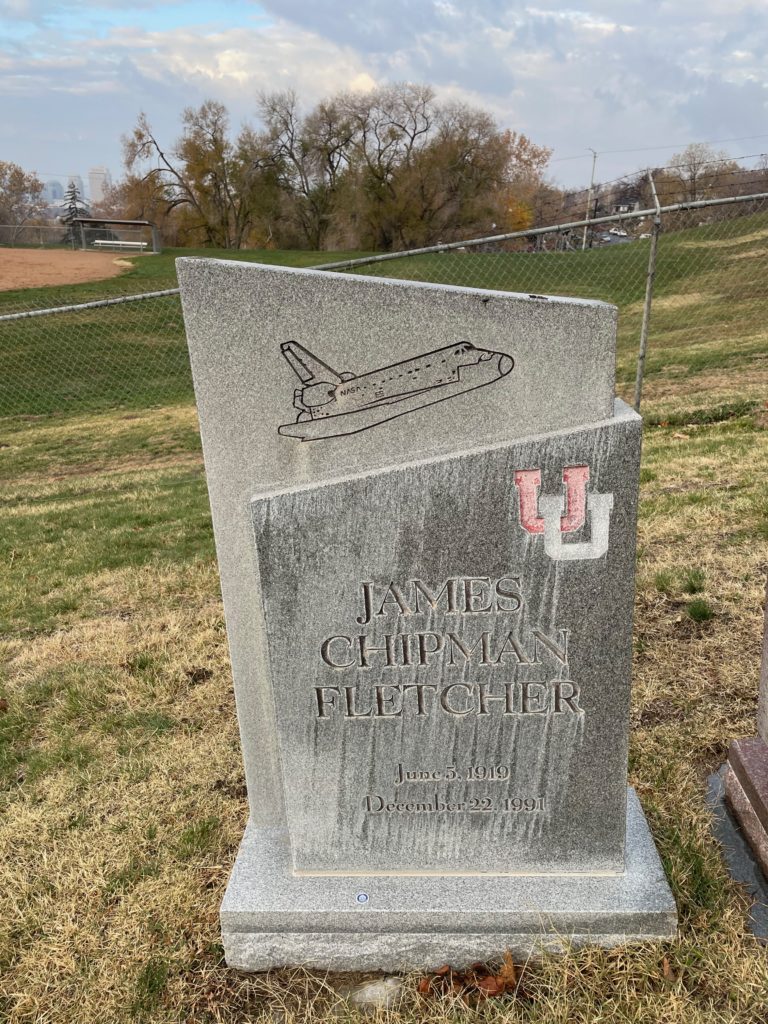Erik Visits an American Grave, Part 1,019
This is the grave of James Fletcher.

Born in 1919 in Milburn, New Jersey, Fletcher grew up in a prominent family dedicated to scientific advancement. His father, Harvey, was a physicist who was one of the inventors of hearing aids and other hearing technologies. This was a Mormon family, but based in New Jersey as Harvey was working at Western Electric at the time. Young Fletcher did not go to BYU though. He might be a devout Mormon, but he wasn’t also a moron and needed to attend a school where scientific inquiry was taken seriously. So he went to Columbia and then to Cal Tech for a PhD in physics. He got teaching jobs at Harvard and Princeton, but this was the Cold War and what leading scientist really needed to teach? There was real money to be made in the military-industrial complex.
Fletcher bailed on boring stuff like “teaching,” as if elite scientists in the Ivy League ever really taught, and took a job with Hughes Aircraft in 1948. As the space race grew in the 1950s, so did Fletcher’s commitment to that over standard aircraft. He led the Guided Missile Division of the Ramo-Wooldridge Corporation for awhile and then started the Space Electronics Corporation. Aerojet then hired him as VP. Blah, blah, military industrial complex firms, etc. He then became president of the University of Utah in 1964, holding that position for seven years. Nixon named him NASA head in 1971.
1971 was an interesting moment at NASA. The moon mission was accomplished. Turns out, not much up there! So why keep going. Which led to the question of just what the point of additional space travel actually was, something that NASA has struggled to answer for a full half-century at this point. Well, Fletcher tried to have answers. For one thing, he helped develop the space shuttle program. The idea of returnable, reusable space craft certainly made sense and of course the space shuttle did lead to a big shot in the arm for the space program until the Challenger explosion in 1986. Like so many young people who was all excited about sending a teacher to space and then got to watch her die on live TV, the space program was pretty much dead to me after that and remains so today. Though I guess that’s not on Fletcher. Anyway, Nixon had ordered the creation of the space shuttle in 1972 and that then became Fletcher’s main task. He also played a big role in the Viking missions to Mars, though that was started before he got to NASA. While he was at NASA, he also had to implement the Skylab plans. He also approved the Voyager program.
When Carter took over in 1977, Fletcher stepped aside and decided to make bank as a consultant. He taught a bit at the University of Pittsburgh (or at least he was associated with the university; guys like that really don’t teach. They just are toys administrators can bring out to impress donors). He also was a big Reagan guy and was one of the architects of the Strategic Defense Initiative, arguably the stupidest idea in American defense policy history. But of course he would be all about spending trillions of dollars on the idea that we need a space force to shoot down nuclear weapons from space.
In 1986, Reagan brought Fletcher back to NASA to revive the agency after the Challenger explosion. His second term was basically making sure the space shuttle could be brought back safely, or relatively so as the astronauts on the Columbia would eventually discover for themselves. But he also provided approval for the Hubble telescope, which is probably the biggest success NASA has had since 1981, at least in terms of public approval. However, this second term was not without scrutiny. In the Challenger aftermath, there was a lot of investigations into just what was going on at NASA. Turns out that Fletcher had approved some sweetheart deals to his Mormon friends in Utah. He was also part of a lobbying group to send military-industrial complex jobs to Utah right up to the point he headed NASA. Congress actually investigated him for conflict of interest violations, but of course he was exonerated, which almost everyone is with these things no matter what actually happened. He resigned in April 1989, though this was not related to those investigations. He just felt it was time to step away and retire. He spent his last years in the elite consultant world.
Fletcher seems to have been a big smoker and he died of lung cancer in 1991. He was 72 years old.
James Fletcher is buried in Salt Lake City Cemetery, Salt Lake City, Utah.
If you would like this series to visit other NASA heads, you can donate to cover the required expenses here. T. Keith Glennon, the first head of the agency, is in Manns Corner, Pennsylvania and James E. Webb, who headed the agency under Kennedy and Johnson, is in Arlington. Previous posts in this series are archived here.


